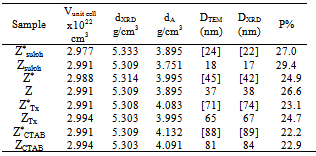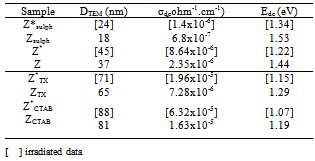-
Paper Information
- Next Paper
- Previous Paper
- Paper Submission
-
Journal Information
- About This Journal
- Editorial Board
- Current Issue
- Archive
- Author Guidelines
- Contact Us
International Journal of Materials and Chemistry
p-ISSN: 2166-5346 e-ISSN: 2166-5354
2012; 2(5): 197-204
doi: 10.5923/j.ijmc.20120205.03
Influences of γ–Radiation and Surfactants on Electrical and Magnetic Properties of Cu0.1Zn0.9Mn2O4 Nanoparticles
M. Khairy, M. A. Mousa
Chemistry Department, Faculty of Science, Benha University, Egypt
Correspondence to: M. Khairy, Chemistry Department, Faculty of Science, Benha University, Egypt.
| Email: |  |
Copyright © 2012 Scientific & Academic Publishing. All Rights Reserved.
Nanosized Cu0.1Zn0.9Mn2O4 were prepared by hydrothermal method in absence and presence of surfactants. The samples were characterized using XRD, SEM and TEM. All samples showed spinel crystal structure with crystallite sizes depending on the preparation method and lay in the range of 17-89 nm. Electrical conductivity as a function of frequency and temperature has been studied. The conductivity results showed that all investigated samples behave like semiconductors and could be explained by hopping mechanism in which the conduction occurres via electron exchange amongst Mn+ and Mn+1 ions situated on octahedral sites in spinel lattice. Room temperature magnetic properties using VSM were studied. Effect of γ-radiation on the studied properties is investigated. Each of particle size, morphology, magnetic and electrical properties is affected with each of the type of surfactant used in the preparation method and γ- irradiation process.
Keywords: Nanosized Cu0.1Zn0.9Mn2O4, Surfactants, Gamma Irradiation, Electrical Properties, Magnetic Properties
Cite this paper: M. Khairy, M. A. Mousa, "Influences of γ–Radiation and Surfactants on Electrical and Magnetic Properties of Cu0.1Zn0.9Mn2O4 Nanoparticles", International Journal of Materials and Chemistry, Vol. 2 No. 5, 2012, pp. 197-204. doi: 10.5923/j.ijmc.20120205.03.
Article Outline
1. Introduction
- Nanoparticles have been investigated intensively in recent years because of their size-dependent properties[1-5]. The synthesis of inorganic structures with nanoscale dimensions and morphological specificity is of a great importance and interest in material science and nanotechnology[1- 2]. After intensive research during the last decade, many techniques have been experimented for the control of shapes and morphologies of different nanomaterials[3, 4].General approaches for shape control and production of anisotropic nanostructures rely on the availability of surfactants, which preferentially absorb on specific crystallographic faces. With ever increasing energy costs, the hydrothermal method could be possibly very attractive for fine powder preparation because of the low temperature involved and the good sinter ability of the formed powders[5, 6] .The electrical and structural properties of nanomaterials are strikingly different from those of their single crystalline, coarse-grained polycrystalline, and thin film counterparts. The dielectric constant of materials changes, when it transforms to nanophase from the bulk form. When compared with thin films, the value of dielectric constant in nanostructured materials is very high[7]. The high surface to volume ratio of the grains, small size, enhanced contribution from grains and grain boundary regions, quantum confinement of charge carriers, band structure modification, and possibility for defects in grains are some of the factors which contribute to the electrical properties of nanostructured materials[7]. This difference between nano and bulk materials has immense theoretical and technological importance.Ionizing radiation such as gamma ray has frequently been used in studies of the physical properties of crystalline solids[8]. Structural defects can be introduced by ionizing radiation. Severe disruption of the lattice of a crystalline solid is possible, with the formation of a large number of defects.Complex manganese oxides have recently evoked strong interest in various structures with different Mn valence states and Mn coordinations for example in perovskites or spinels. The manganites display a vast range of fascinating electrical and magnetic properties, which often come about due to the mixed valence states of manganese. ZnMn2O4 is one of the promising materials which can be used as negative temperature coefficient (NTC) thermistors[9], as catalytic material[10] and as cathodic material of the secondary batteries[11] due to their excellent electrochemical properties. Doping materials can be used to induce and improve the properties of this material.As a part of our program to prepare nanomaterials of pure and substituted transition metal ZnMn2O4 and study their physical properties; this work was designed to prepare nanosized Cu0.1Zn0.9Mn2O4 by hydothermal method in absence and in presence of different surfactants. The materials obtained were characterized by X-ray diffraction (XRD), scanning electron microscopy (SEM) and transmission electron microscopy (TEM). Electrical properties (conductivity, dielectric constant and dielectric loss) as well as magnetic properties of the produced materials were studied. The effect of γ-irradiation on all the measured properties as well as the magnetic and electrical properties (conductivity, dielectric constant and dielectric loss) was also studied.
2. Experiments
2.1. Materials
- All the chemical reagents used in the experiment were A.R. grade and used without further purification and treatment. The surfactants used in the preparation method were divided into three different groups:(a) cationic surfactants: cetyl trimethyl ammonium- bromide (CTAB){ CH3(CH2)15N(CH3)3Br } (98%) provided from Aldrich; (b) anionic surfactants: dodecylbenzene sulphonic acid (Sulph){CH3(CH2)11C6H4SO3H} provided from chemicals and dyes company, Kafr El Doar and (c) nonionic surfactants: triton X-100 (TX) {C14H22O(C2H4O)n} provided from Arsamco.
2.2. Preparation
- A mixed solution of 1 ml H2O2 (4%) and 8 ml NaOH (0.6 M) was poured slowly into a Teflon-lined stainless-steel autoclave filled with 4 ml Mn(NO3)2 (0.3 M) and 5 ml surfactant (CTAB, TX or sulph) (5×10-3 M) while stirring vigorously, and the reaction solution was continually stirred and kept for 20 min. at the room temperature. 0.02mmol (3.28 gm) Mn(NO3)2, 9×10-3 mmol (0.2.67gm) Zn(NO3)2·6H2O (GFS Chemicals), 1×10-3 mmol ( 0.24 gm) Cu(NO3)2·3H2O (Merck) and surfactant (CTAB, TX or sulph) (5×10-3 M) were mixed in ~100 ml of distilled water to form Cu0.1Zn0.9Mn2O4. After that the reaction solutions were hydrothermally heated at 500 K for four days. The samples were cooled to room temperature, then the precipitates were filtered and washed with distilled water several times until pH=7, and finally dried in an oven at 360 K.Half of the prepared samples was irradiated by γ-ray source using a 60Co gamma cell ( 60Co gamma cell 2000 Ci with a dose rate of 1.5 Gy/s (150 rad/s) at a temperature of 30 oC. Each sample was subjected to a total final dose of 1x105 Gy (10 Mrad).The prepared samples are denoted as Z, ZCTAB , ZTX, and Zsulph for the samples prepared without surfactant and by using CTAB, TX, and sulph surfactant, respectively.The irradiated sample is denoted by *.
2.3. Characterization
- X- ray diffraction (XRD) were performed on the investigated samples using a Philips X’Pert Pro Super diffractometer with Cu Kα radiation (λ = 1.54 Å) in the range of 2θ = 10-800. The density was determined by both the immersion Archimedes method and X- ray diffraction. Electron microscopes analysis using SEM and TEM were taken by an electron microscope model JEM-5200 Joel and Joel 2010, respectively. For electrical measurements, the powder samples were pressed uniaxially into a pellet of thickness 1–2 mm and of diameter 7 mm by applying pressure of ~ 0.3 Gpa for 3 min. Both faces of the pellets were coated with fine quality silver paint for good electrical contacts. Dc conductivity was measured in the temperature range 300-400 K by the four terminal technique. The temperature was limited to 400 K to prevent grain growth and to ensure that the main particle size remained the same in the entire temperature range. Ac conductivity was measured by the two-probe method using Fluke PM 6306 programmable automatic (RCL) bridge at frequencies from 102 – 106 Hz over the same temperature range used in dc-measurements. The hysteresis loop, saturation magnetization (Ms) and coercivity (Hc) of the materials under study were also measured by means of VSM at a maximum applied field of 15 kG at room temperature.
3. Results and Discussion
3.1. Structural Characterization
 | Figure 1. XRD patterns for: a) ZCTAB b) ZTX c) Z d) Zsulph |
 | (1) |
 | (2) |
|
 | (3) |
 | (4) |
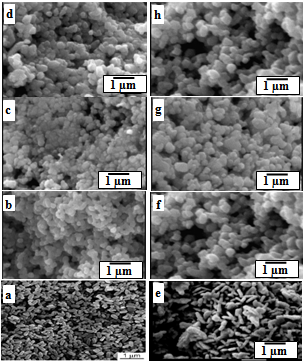 | Figure 2. SEM: a) ZCTAB b) ZTX c) Z d) Zsulph e) Z*CTAB f) Z*TX g) Z* h) Z*sulph |
 | Figure 3. TEM: a) Zsulph b) Z c) ZTX d)ZCTAB e) Z*sulph f ) Z* g) Z*TX h) Z*CTAB |
3.2. Electrical Properties
3.2.1. Dc Conductivity
- The electrical properties of transition metal oxides with spinel structure depend on several factors, including the method of synthesis, grain size and chemical composition. The dc-conductivity (σdc) of the samples investigated is evaluated using the relation:
 | (5) |
 | (6) |
 | Figure 4. The temperature dependence of DC-conductivity for: (♦), ZSulph; (■), Z; (▲), ZTX; (●), ZCTAB |
 | (5) |
|
3.2.2. AC-conductivity
- In order to give information on the type of polarization present in the samples, the ac-electrical conductivity (σac), at temperatures range of 300-400 K and at frequency range of 102 – 106 Hz were studied. The ac-conductivity σac (ω) was calculated according to
 | (7) |
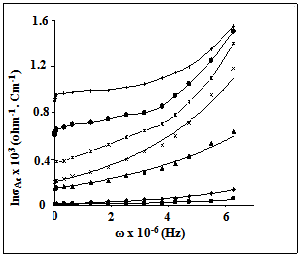 | Figure 5. The frequency dependence of AC-conductivity for: (■); Z(Sulph), (♦);Z, (▲); ZTX, (x); ZCTAB(300K), ( ); ZCTAB(340K), (●); ZCTAB(380K), (+); ZCTAB(400K) ); ZCTAB(340K), (●); ZCTAB(380K), (+); ZCTAB(400K) |
3.2.3. Dielectric Behavior
- The frequency dependence of dielectric constant ε`and dielectric loss ε`` of nanosized Cu0.1Zn0.9Mn2O4 at different temperatures is studied. A similar trend is observed for all irradiated and unirradiated samples, some typical plots are shown in Fig 6 and Fig. 7. It shows dielectric dispersion where both real and imaginary dielectric constant decreases rapidly with increasing frequency in low-frequency region while it approaches almost frequency independent behaviour in high frequency region. The decrease in imaginary part of dielectric constant is pronounced more in comparison to real dielectric constant. The dielectric dispersion curve can be explained on the basis of Koop's theory[21] based on the Maxwell–Wagner model for the in-homogeneous double structure[22]. According to this model the dielectric structure was supposed to be composed of the double layer. The first layer is of fairly well conducting materials, which is separated by the second thin layer (grain boundaries) of relatively poor conducting substance. The grain boundaries were found to be more effective at lower frequencies while the magnetite grains are more effective at higher frequencies. In present samples, Cu0.1Zn0.9Mn2O4 are dipolar materials due to the presence of majority Mn3+ ions and minority divalent ions in them. The electron exchange between trivalent and divalent ions gives local displacement of electrons in the direction of applied electric field thus inducing polarization in manganite. The decrease in the complex permittivity with increasing frequency is explained to be due to the decrease of polarization of the dipoles when electric field propagates with high frequency. In other words, in dielectric nanostructured samples, interfaces with large volume fractions contain a large number of defects, such as dangling bonds, vacancies, vacancy clusters, and micro porosities, which can cause a change of positive and negative space charge distribution in interfaces. When subjected to an electric field, these space charges move. When they are trapped by defects, a lot of dipole moments are formed. At low frequency region these dipole moments are easy to follow the change of the electric field[23]. So the dielectric loss and hence the dielectric constant shows a large value at low frequency.For all investigated samples, the dielectric constant ε` was found to increase with increasing the particle size. This can be explained on the basis of many factors, such as amorphousness of surface, high surface energy, micro mechanical stress, surface domain depolarisation, domain wall effects, and so on.
 | Figure 6. The frequency dependence of dielectric constant of: (●), ZSulph; (▲), Z; (■), ZTX; ( ♦), ZCTAB(300K); ( ), ZCTAB(400K) ), ZCTAB(400K) |
 | Figure 7. The frequency dependence of dielectric loss of : (●), ZSulph; (▲), Z; (■), ZTX; ( ♦), ZCTAB(300K), ( ), ZCTAB(400K). ), ZCTAB(400K). |
3.3. Magnetic Properties
- Vibrating sample magnetometer (VSM) was used to investigate the magnetic properties of γ-irradiated and unirradiated Cu0.1Zn0.9Mn2O4 at room temperature. All samples showed narrow hysteresis loops, indicating their slight ferromagnetism. Typical plot is shown in Fig. 8. The irradiated ones showed the same behavior. The saturation magnetizations Ms of the samples were found by extrapolating M vs. 1/H plot to 1/H=0. The variation trend of Ms, Hc and Mr was illustrated in Table 3. From which it can be seen that magnetization (Ms) values for irradiated are higher than unirradiated ones and increase in the following order: ZCTAB > ZTX > Z > Zsulph
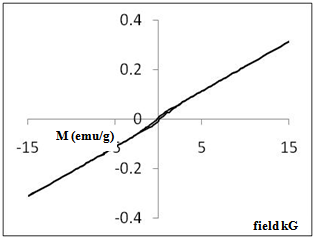 | Figure 8. Room temperature magnetic hysteresis loop of Z sample |
|
4. Conclusions
- Nanocrystalline Cu0.1Zn0.9Mn2O4 were prepared in the range of 18-85 nm using hydrothermal method in presence and absence of surfactants. XRD showed a tetragonal spinel structure for the γ- irradiated and unirradiated samples. The size of the prepared particles has been confirmed through X-ray diffraction and TEM techniques. SEM and TEM images showed surface and particle morphology depends on each of the type of surfactants used and irradiation process. The pores sizes became also smaller after γ-irradiation process. Both ac- and dc-conductivity follows Arrhenius-type thermally activated conduction over temperature range investigated and referring to a semiconducting behavior for the γ-irradiated and unirradiated nano Cu0.1Zn0.Mn2O4 samples. The irradiation process causes an increase in the conductivity values. Hopping mechanism between different oxidation states of Mn-ions in Cu2+0.1 Zn2+0.9[Mn3+ 2-2x Mn2+xMn4+x] O42-samples is used to explain the conducting behavior. The dielectric constant (ε′) and dielectric loss factor (ε′′) decreases exponentially with increasing the measured frequencies and increases with increasing temperature at each individual frequency due to the relaxation of the dipole molecules. All studied samples showed ferromagnetic behavior which increases with increasing each of the particle size and irradiation process. The relation between morphology (nano rod) and magnetic performance is observed.
 Abstract
Abstract Reference
Reference Full-Text PDF
Full-Text PDF Full-Text HTML
Full-Text HTML